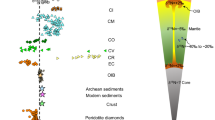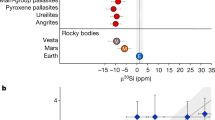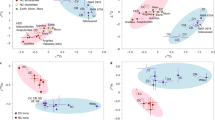Abstract
Understanding the origin of life-essential volatiles such as nitrogen (N) in the Solar System and beyond is critical to evaluate the potential habitability of rocky planets1,2,3,4,5. Whether the inner Solar System planets accreted these volatiles from their inception or had an exogenous delivery from the outer Solar System is, however, not well understood. Using previously published data of nucleosynthetic anomalies of nickel, molybdenum, tungsten and ruthenium in iron meteorites along with their 15N/14N ratios, here we show that the earliest formed protoplanets in the inner and outer protoplanetary disk accreted isotopically distinct N. While the Sun and Jupiter captured N from nebular gas6, concomitantly growing protoplanets in the inner and outer disk possibly sourced their N from organics and/or dust—with each reservoir having a different N isotopic composition. A distinct N isotopic signature of the inner Solar System protoplanets coupled with their rapid accretion7,8 suggests that non-nebular, isotopically processed N was ubiquitous in their growth zone between 0 and ~0.3 Myr after Solar System formation. Because the 15N/14N ratio of the bulk silicate Earth falls between that of the inner and outer Solar System reservoirs, we infer that N in the present-day rocky planets represents a mixture of both inner and outer Solar System material.
This is a preview of subscription content, access via your institution
Access options
Access Nature and 54 other Nature Portfolio journals
Get Nature+, our best-value online-access subscription
$29.99 / 30 days
cancel any time
Subscribe to this journal
Receive 12 digital issues and online access to articles
$119.00 per year
only $9.92 per issue
Buy this article
- Purchase on Springer Link
- Instant access to full article PDF
Prices may be subject to local taxes which are calculated during checkout




Similar content being viewed by others
Data availability
The authors declare that the data supporting the findings of this study are available within the article and its Supplementary Information files.
References
Piani, L. et al. Earth’s water may have been inherited from material similar to enstatite chondrite meteorites. Science 369, 1110–1113 (2020).
Grewal, D. S., Dasgupta, R., Sun, C., Tsuno, K. & Costin, G. Delivery of carbon, nitrogen, and sulfur to the silicate Earth by a giant impact. Sci. Adv. 5, eaau3669 (2019).
Alexander, C. M. O. D., Cody, G. D., De Gregorio, B. T., Nittler, L. R. & Stroud, R. M. The nature, origin and modification of insoluble organic matter in chondrites, the major source of Earth’s C and N. Chem. Erde 77, 227–256 (2017).
Marty, B. The origins and concentrations of water, carbon, nitrogen and noble gases on Earth. Earth Planet. Sci. Lett. 313–314, 56–66 (2012).
Dasgupta, R. & Grewal, D. S. in Deep Carbon: Past to Present (eds Orcutt, B. et al.) 4–39 (Cambridge Univ. Press, 2019); https://doi.org/10.1017/9781108677950.002
Marty, B., Chaussidon, M., Wiens, R. C., Jurewicz, A. J. G. & Burnett, D. S. A 15N-poor isotopic composition for the Solar System as shown by genesis solar wind samples. Science 332, 1533–1536 (2011).
Kruijer, T. S. et al. Protracted core formation and rapid accretion of protoplanets. Science 344, 1150–1154 (2014).
Kruijer, T. S., Burkhardt, C., Budde, G. & Kleine, T. Age of Jupiter inferred from the distinct genetics and formation times of meteorites. Proc. Natl. Acad. Sci. USA https://doi.org/10.1073/pnas.1704461114 (2017).
Raymond, S. N. & Izidoro, A. Origin of water in the inner Solar System: planetesimals scattered inward during Jupiter and Saturn’s rapid gas accretion. Icarus 297, 134–148 (2017).
Morbidelli, A., Lunine, J. I., O’Brien, D. P., Raymond, S. N. & Walsh, K. J. Building terrestrial planets. Annu. Rev. Earth Planet. Sci. 40, 251–275 (2012).
Schiller, M., Bizzarro, M. & Fernandes, V. A. Isotopic evolution of the protoplanetary disk and the building blocks of Earth and the Moon. Nature 555, 501–510 (2018).
Dauphas, N. The isotopic nature of the Earth’s accreting material through time. Nature 541, 521–524 (2017).
Javoy, M., Pineau, F. & Demaiffe, D. Nitrogen and carbon isotopic composition in the diamonds of Mbuji Mayi (Zaïre). Earth Planet. Sci. Lett. 68, 399–412 (1984).
Grady, M. M. & Wright, I. P. Elemental and isotopic abundances of carbon and nitrogen in meteorites. Space Sci. Rev. 106, 231–248 (2003).
Sugiura, N. & Fujiya, W. Correlated accretion ages and ε54Cr of meteorite parent bodies and the evolution of the solar nebula. Meteorit. Planet. Sci. 49, 772–787 (2014).
Warren, P. H. Stable-isotopic anomalies and the accretionary assemblage of the Earth and Mars: a subordinate role for carbonaceous chondrites. Earth Planet. Sci. Lett. 311, 93–100 (2011).
Desch, S. J., Kalyaan, A. & Alexander, C. M. O'D. The effect of Jupiter’s formation on the distribution of refractory elements and inclusions in meteorites. Astrophys. J. Suppl. Ser. 238, 11 (2018).
Burkhardt, C., Dauphas, N., Hans, U., Bourdon, B. & Kleine, T. Elemental and isotopic variability in Solar System materials by mixing and processing of primordial disk reservoirs. Geochim. Cosmochim. Acta 261, 145–170 (2019).
Prombo, C. A. & Clayton, R. N. Nitrogen isotopic compositions of iron meteorites. Geochim. Cosmochim. Acta 57, 3749–3761 (1993).
Franchi, I. A., Wright, I. P. & Pillinger, C. T. Constraints on the formation conditions of iron meteorites based on concentrations and isotopic compositions of nitrogen. Geochim. Cosmochim. Acta 57, 3105–3121 (1993).
Charnley, S. B. & Rodgers, S. D. The end of interstellar chemistry as the origin of nitrogen in comets and meteorites. Astrophys. J. 569, L133–L137 (2002).
Kuga, M., Marty, B., Marrocchi, Y. & Tissandier, L. Synthesis of refractory organic matter in the ionized gas phase of the solar nebula. Proc. Natl Acad. Sci. USA 112, 7129–7134 (2015).
Owen, T., Mahaffy, P. R., Niemann, H. B., Atreya, S. & Wong, M. Protosolar nitrogen. Astrophys. J. 553, 77–79 (2001).
Meibom, A. et al. Nitrogen and carbon isotopic composition of the Sun inferred from a high-temperature solar nebular condensate. Astrophys. J. 656, L33–L36 (2007).
Grewal, D. S. et al. The fate of nitrogen during core–mantle separation on Earth. Geochim. Cosmochim. Acta 251, 87–115 (2019).
Righter, K., Sutton, S. R., Danielson, L., Pando, K. & Newville, M. Redox variations in the inner Solar System with new constraints from vanadium XANES in spinels. Am. Mineral. 101, 1928–1942 (2016).
Yang, J., Goldstein, J. I. & Scott, E. R. D. Iron meteorite evidence for early formation and catastrophic disruption of protoplanets. Nature 446, 888–891 (2007).
Budde, G., Burkhardt, C. & Kleine, T. Molybdenum isotopic evidence for the late accretion of outer Solar System material to Earth. Nat. Astron. 3, 736–741 (2019).
Okazaki, R., Takaoka, N., Nagao, K., Sekiya, M. & Nakamura, T. Noble-gas-rich chondrules in an enstatite meteorite. Nature 412, 795–798 (2001).
Chakraborty, S. et al. Massive isotopic effect in vacuum UV photodissociation of N2 and implications for meteorite data. Proc. Natl Acad. Sci. USA 111, 14704–14709 (2014).
Füri, E., Chaussidon, M. & Marty, B. Evidence for an early nitrogen isotopic evolution in the solar nebula from volatile analyses of a CAI from the CV3 chondrite NWA 8616. Geochim. Cosmochim. Acta 153, 183–201 (2015).
Hirschmann, M. M. Comparative deep Earth volatile cycles: the case for C recycling from exosphere/mantle fractionation of major (H2O, C, N) volatiles and from H2O/Ce, CO2/Ba, and CO2/Nb exosphere ratios. Earth Planet. Sci. Lett. 502, 262–273 (2018).
Cartigny, P. & Marty, B. Nitrogen isotopes and mantle geodynamics: the emergence of life and the atmosphere–crust–mantle connection. Elements 9, 359–366 (2013).
Nanne, J. A. M., Nimmo, F., Cuzzi, J. N. & Kleine, T. Origin of the non-carbonaceous–carbonaceous meteorite dichotomy. Earth Planet. Sci. Lett. 511, 44–54 (2019).
Speelmanns, I. M., Schmidt, M. W. & Liebske, C. Nitrogen solubility in core materials. Geophys. Res. Lett. 45, 7434–7443 (2018).
Murty, S. V. S., Goel, P. S., Minh, D. V. & Shukolyukov, Y. A. Nitrogen and xenon in acid residues of iron meteorites. Geochim. Cosmochim. Acta 47, 1061–1068 (1983).
Sugiura, N., Ikeda, Y., Zashu, S. & Wasson, J. T. Nitrogen-isotopic compositions of IIIE iron meteorites. Meteorit. Planet. Sci. 35, 749–756 (2000).
Pepin, R. O. & Becker, R. H. Nitrogen isotopes in iron meteorites. Meteoritics 17, 269 (1982).
Murty, S. V. S. & Marti, K. Nitrogen isotopic signatures in Cape York: implications for formation of group III A irons. Geochim. Cosmochim. Acta 58, 1841–1848 (1994).
Sugiura, N. Ion probe measurements of carbon and nitrogen in iron meteorites. Meteorit. Planet. Sci. 33, 393–409 (1998).
Shukla, P. N. & Goel, P. S. Total nitrogen in iron meteorites. Earth Planet. Sci. Lett. 52, 251–258 (1981).
Kothari, B. K. & Goel, P. S. Total nitrogen in meteorites. Geochim. Cosmochim. Acta 38, 1493–1507 (1974).
Ponganis, K. V. & Marti, K. Nitrogen components in IAB/IIICD iron meteorites. Meteorit. Planet. Sci. 42, 331–346 (2007).
Mathew, K. J., Palma, R. L., Marti, K. & Lavielle, B. Isotopic signatures and origin of nitrogen in IIE and IVA iron meteorites. Geochim. Cosmochim. Acta 64, 545–557 (2000).
Gibson, E. K. & Moore, C. B. The distribution of total nitrogen in iron meteorites. Geochim. Cosmochim. Acta 35, 877–890 (1971).
Goldstein, J. I., Scott, E. R. D. & Chabot, N. L. Iron meteorites: crystallization, thermal history, parent bodies, and origin. Chem. Erde 69, 293–325 (2009).
Scott, E. R. D. Chemical fractionation in iron meteorites and its interpretation. Geochim. Cosmochim. Acta 36, 1205–1236 (1972).
Li, Y., Marty, B., Shcheka, S., Zimmermann, L. & Keppler, H. Nitrogen isotope fractionation during terrestrial core–mantle separation. Geochem. Perspect. Lett. 2, 138–147 (2016).
Dalou, C. et al. Redox control on nitrogen isotope fractionation during planetary core formation. Proc. Natl Acad. Sci. USA 116, 14485–14494 (2019).
Dalou, C., Hirschmann, M. M., von der Handt, A., Mosenfelder, J. & Armstrong, L. S. Nitrogen and carbon fractionation during core–mantle differentiation at shallow depth. Earth Planet. Sci. Lett. 458, 141–151 (2017).
Young, E. D. et al. High-temperature equilibrium isotope fractionation of non-traditional stable isotopes: experiments, theory, and applications. Chem. Geol. 395, 176–195 (2015).
Bourdon, B., Roskosz, M. & Hin, R. C. Isotope tracers of core formation. Earth Sci. Rev. 181, 61–81 (2018).
Shahar, A., Elardo, S. M. & Macris, C. A. Equilibrium fractionation of non-traditional stable isotopes: an experimental perspective. Rev. Mineral. Geochem. 82, 65–83 (2017).
Righter, K. & Drake, M. J. Core formation in Earth’s Moon, Mars, and Vesta. Icarus 124, 513–529 (1996).
Kung, C. C. & Clayton, R. N. Nitrogen abundances and isotopic compositions in stony meteorites. Earth Planet. Sci. Lett. 38, 421–435 (1978).
Füri, E. & Marty, B. Nitrogen isotope variations in the Solar System. Nat. Geosci. 8, 515–522 (2015).
Bekaert, D. V. et al. High-temperature ionization-induced synthesis of biologically relevant molecules in the protosolar nebula. Astrophys. J. 859, 142 (2018).
Pontoppidan, K. M. et al. The nitrogen carrier in inner protoplanetary disks. Astrophys. J. 874, 92 (2019).
Lewis, J. S. & Prinn, R. G. Kinetic inhibition of CO and N2 reduction in the solar nebula. Astrophys. J. 238, 357–364 (1980).
Cuzzi, J. N. & Weidenschilling, S. J. in Meteorites and the Early Solar System II (eds Lauretta, D. S. & McSween, H. Y. Jr) 353–381 (Univ. Arizona Press, 2006).
Cuzzi, J. N. et al. in Chondrites and the Protoplanetary Disk Vol. 341 (eds Krot, A. N. et al.) 732–773 (ASP, 2005).
Mori, T., Shinmyo, K., Ichise, E. & Koyama, S. Effects of nickel on the activity of nitrogen in austenite. J. Jpn Inst. Metals Mater. 27, 53–58 (1963).
Wada, H. & Pehlke, R. D. Solubility of nitrogen in liquid Fe–Cr–Ni alloys containing manganese and molybdenum. Metall. Trans. B 8, 675–682 (1977).
Satir-Kolorz, A. H. & Feichtinger, H. K. On the solubility of nitrogen in liquid iron and steel alloys using elevated pressure. Z. Metall. 82, 689–697 (1991).
Scott, E. R. D. & Wasson, J. T. Classification and properties of iron meteorites. Rev. Geophys. 13, 527–546 (1975).
Fegley, B. Primordial retention of nitrogen by terrestrial planets and meteorites. J. Geophys. Res. 88, A853 (1983).
Mittlefehldt, D. W., McCoy, T. J., Goodrich, C. A. & Kracher, A. Non-chondritic meteorites from asteroidal bodies. Rev. Mineral. Geochem. 36, 4.1–4.195 (1998).
Yang, J., Goldstein, J. I. & Scott, E. R. D. Metallographic cooling rates and origin of IVA iron meteorites. Geochim. Cosmochim. Acta 72, 3043–3061 (2008).
Asphaug, E., Agnor, C. B. & Williams, Q. Hit-and-run planetary collisions. Nature 439, 155–160 (2006).
Steenstra, E. S., Knibbe, J. S., Rai, N. & van Westrenen, W. Constraints on core formation in Vesta from metal–silicate partitioning of siderophile elements. Geochim. Cosmochim. Acta 177, 48–61 (2016).
Rubie, D. C. et al. Heterogeneous accretion, composition and core-mantle differentiation of the Earth. Earth Planet. Sci. Lett. 301, 31–42 (2011).
Hilton, C. D. & Walker, R. J. New implications for the origin of the IAB main group iron meteorites and the isotopic evolution of the noncarbonaceous (NC) reservoir. Earth Planet. Sci. Lett. 540, 116248 (2020).
Ruzicka, A. Silicate-bearing iron meteorites and their implications for the evolution of asteroidal parent bodies. Geochemistry 74, 3–48 (2014).
Ku, Y. & Jacobsen, S. B. Potassium isotope anomalies in meteorites inherited from the protosolar molecular cloud. Sci. Adv. 6, eabd0511 (2020).
Worsham, E. A. et al. Distinct evolution of the carbonaceous and non-carbonaceous reservoirs: insights from Ru, Mo, and W isotopes. Earth Planet. Sci. Lett. 521, 103–112 (2019).
Nicolussi, G. K. et al. Molybdenum isotopic composition of individual presolar silicon carbide grains from the murchison meteorite. Geochim. Cosmochim. Acta 62, 1093–1104 (1998).
Amari, S., Nittler, L. R., Zinner, E., Lodders, K. & Lewis, R. S. Presolar SiC grains of type A and B: their isotopic compositions and stellar origins. Astrophys. J. 559, 463–483 (2001).
Rodgers, S. D. & Charnley, S. B. Nitrogen superfractionation in dense cloud cores. Mon. Not. R. Astron. Soc. 385, 48–52 (2008).
Busemann, H. et al. Interstellar chemistry recorded in organic matter from primitive meteorites. Science 312, 727–730 (2006).
Alexander, C. M. O. et al. The provenances of asteroids, and their contributions to the volatile inventories of the terrestrial planets. Science 337, 721–723 (2012).
Grady, M. M., Wright, I. P., Carr, L. P. & Pillinger, C. T. Compositional differences in enstatite chondrites based on carbon and nitrogen stable isotope measurements. Geochim. Cosmochim. Acta 50, 2799–2813 (1986).
Acknowledgements
We acknowledge C.-T. Lee for fruitful discussions during the early stage of this research. A. Vyas and J. D. Seales helped with the CC–NC reservoir mixing calculations for the BSE. A. P. Vyas helped improve the clarity of our communication. D.S.G. received support from NASA FINESST grant 80NSSC19K1538 and Lodieska Stockbridge Vaughn Fellowship by Rice University. R.D. was supported by NASA grants 80NSSC18K0828 and 80NSSC18K1314. B.M. was supported by the European Research Council grant PHOTONIS 695618.
Author information
Authors and Affiliations
Contributions
D.S.G. conceived the project, compiled the data and developed thermodynamic models. D.S.G., R.D. and B.M. interpreted the data. D.S.G. wrote the manuscript with input from R.D. and B.M.
Corresponding author
Ethics declarations
Competing interests
The authors declare no competing interests.
Additional information
Peer review information Nature Astronomy thanks Bruce Fegley and the other, anonymous, reviewer(s) for their contribution to the peer review of this work.
Publisher’s note Springer Nature remains neutral with regard to jurisdictional claims in published maps and institutional affiliations.
Extended data
Extended Data Fig. 1 Statistical variation of N abundances and isotope ratios in different groups of iron meteorites.
Probability distributions function using kernel density distribution function (using Matlab®) are used to ascertain the statistical variation of N abundances and isotope ratios for each group of iron meteorites. For each group, δ15N varies within a small range and shows sharp peaks for mean values, while N abundances show large variation.
Extended Data Fig. 2 δ15N of iron meteorites plotted against their N abundances.
For each iron meteorite group, δ15N falls in a narrow range, while N contents may vary over two orders of magnitude. Lack of any relationship between δ15N values and N abundances within any given group of iron meteorites argues against notable mass-dependent fractionation of N isotopes via volatility-related losses during planetary processing19,20,44.
Extended Data Fig. 3 Partitioning of N into Fe, Ni-alloy melts can explain N abundances for a variety of core-mantle differentiation scenarios.
a) For alloy-silicate equilibration at 1,000 bar-1,600 °C and varying alloy/silicate mass ratio between 0.01 and 1 (within the range of all differentiated rocky bodies in the inner Solar System except Mercury), N content in the core forming Fe, Ni-alloy melts varies between ~10 and 100 ppm. Fixed values of N content in the alloy at ~100 ppm are owing to low N solubility in the alloy at 1000 bar. b) For alloy-silicate equilibration at 10,000 bar-1,600 °C and varying alloy/silicate mass ratio, N content in the core forming Fe, Ni-alloy melts varies between ~10 and 10,000 ppm. The pink shaded regions represent the range of N contents in iron meteorites.
Supplementary information
Supplementary Table 1
A compilation, in machine-readable format, of N abundances and isotopic ratios in iron meteorites.
Supplementary Table 2
A compilation, in machine-readable format, of N isotopic ratios and isotopic anomalies in iron meteorites and rocky bodies in the inner Solar System.
Rights and permissions
About this article
Cite this article
Grewal, D.S., Dasgupta, R. & Marty, B. A very early origin of isotopically distinct nitrogen in inner Solar System protoplanets. Nat Astron 5, 356–364 (2021). https://doi.org/10.1038/s41550-020-01283-y
Received:
Accepted:
Published:
Issue Date:
DOI: https://doi.org/10.1038/s41550-020-01283-y
This article is cited by
-
Accretion of the earliest inner Solar System planetesimals beyond the water snowline
Nature Astronomy (2024)
-
Nitrogen isotopic ratio and abundance in selected ordinary chondrites: clues for their formation in proto-planetary disk
Astrophysics and Space Science (2023)
-
Determination of the initial hydrogen isotopic composition of the solar system
Nature Astronomy (2022)
-
Origin of life-forming volatile elements in the inner Solar System
Nature (2022)
-
Nitrogen isotope evidence for Earth’s heterogeneous accretion of volatiles
Nature Communications (2022)



